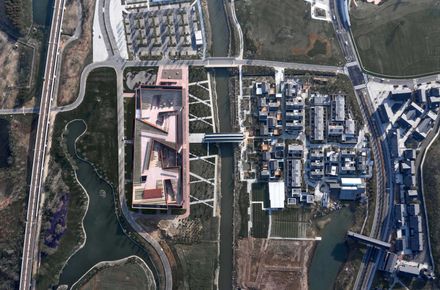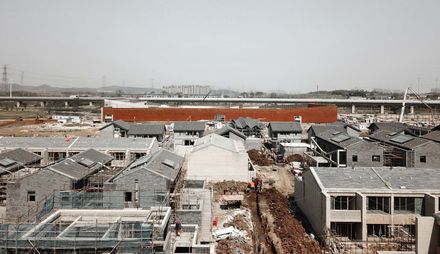
Jiangsu Garden Expo Treasure Pavilion
ARCHITECTS
Azl Architects
CLIENT TEAM
Wei Li, Chongxu Wang
PRINCIPAL ARCHITECTS
Lei Zhang, Wei Qi, Chenxing Li
DESIGN TEAM
Chenxing Li, Liang Wang, Cheng Zhang
CONSTRUCTION DRAWING DESIGN
Nanjing Yangtze River Urban Architectural Design Co. Ltd.
LANDSCAPE
Min Zhao, Zhiyuan Jiang, Hao Lian
TEXT
Chenxing Li, Lei Zhang
INTERIOR DESIGN
Haiyi Ma, Yi Cao, Rong Huang, Yingjie Chen, Mingxing Peng, Sirui Pu, Tiantian Luo
PHOTOGRAPHS
Bowen Hou, Fangfang Tian, Kai Wang
AREA
15500 M²
YEAR
2021
LOCATION
NANJING, CHINA
CATEGORY
MUSEUM
Text description provided by architect.
Jiangsu Garden Expo Treasure Pavilion is located on the far north of Jiangsu Garden Expo Park. Inside of it, the Pavilion displays both traditional handicrafts and folkarts to the public. The whole structure covers an area of 15,000 square meters with a total construction area of 15,500 square meters.
Located at the edge of the Expo Park, the Treasure Pavilion is surrounded by a very conflictingenvironment: on its north side, the Beijing-Shanghai high-speed train constantly runs by ; on its south side, right across a river, there is the VOCO Nanjing Garden Expo, a quiet and pleasant small scale village-sense apartment hotel complex. The city and the village collide on this marginal plot.
Folding, a concept originated from geology, describes the crustal movement squeezing rock layers into folds, and creating the flexed textures. The project is located in Tangshan-Fangshan GeoPark, whose famous six stratigraphic sections are the classic sections for geological teaching practice.
Architecture design continues the site context by spatial folding. Starting from the area, the site, the pathway, and the material, the design talks about the relationship between building and site, plans visiting and wandering pathways, and incorporates the memory and timeliness into the space.
The application of “Folding” concept connects all these thoughts into a whole, with a simple external form and rich spatial contents.There is the VOCO Nanjing Garden Expo, a quiet and pleasant small scale village-sense apartment hotel complex. The city and the village collide on this marginal plot.
Due to urban expansion and ecological conservation, the Chinese Cement Factoryonce famous in the industry, was closed and relocated away in recent years. The construction of the Garden Expo Park now becomes a sustainable strategy for the city development . Previous production of cement and mining makes a flat and low-lying terrain center in the Garden Expo Park, while the surroundings are all covered with mountains.
The Treasure Pavilion is located at the north edge of the Park, on a narrow green belt between the mountains and a high-speed railway line. The planned construction site is one-hundred-ninety meters long, seventy-five meters wide, and the height limit goes to eight meters high.
Facing the challenges created by the site, the architects adoptthe strategy of “heaviness", sinking the building into the site and merging it with the land. The “Folding” idea creates a rich roof/ground form while the building itself becomes a piece of fragment on the land.
Several free broken lines dividethe roof/ground from east to west into three parts, with different heights and nested to each other. The east and west ends are slightly raised up, and the footpaths wedgeinto the upturned volume from different directions, while the central zigzag naturally connects the entrance square with the roof garden.
The main part of the exhibition hall is located on the ground floor, where the open sunken courtyard, curved walls, and landscaped steps lead the ground floor into the ground naturally.
At the same time, all the large and small holes in the outer walls on the ground floor extend the views of the surrounding environment from four directions towards the interior, delivering a sense of the building extended on the ground.
The connection between the building and the site is reflected in two ways of "being seen". While viewing the building from the Beijing and Shanghai high-speed railway, people can see winding rust-red folded walls, changing light and shadows, and linear arrangements of green plants, all becoming the natural strokes on the canvas of the earth.
The building’s fifth facade — the roof, opens freely to the sky. While walk-on the landscape steps from the sunken courtyard and then zigzag several times to the second floor’s rooftop, the high-view bending integrates into the flat and open earth.
On the south side of the Treasure Pavilion, there locates the VOCO Nanjing Garden Expo Hotel complex, whose buildings adopt a village community layout, with small-scale structures and pitched roofs.
While looking towards the Treasure Pavilion from the streets of the Hotel, a narrow and long red mountain-like background shows up. On the building’s two-hundred-meter-long outer wall, there is a very limited number of openings and one tall, slender window.
The center of the wall goes gently, while the two ends are slightly raised up, just like the view surrounded by undulating mountains.
Different from the building’s freely opened roof, which enjoys abundant views, the four elevations connecting the Pavilion to the ground are deliberately weakened, but still very powerful, just like Richard Serra's tension-filled rust-steel sculptures.
The volume of the Treasure Pavilion is almost a rectangular shape, and only concave at the building’s northeast and southwest corners. Thus, there are two different heights of volumes overlapping on each corner, which eliminates the tensions caused by the large volume and makes the close viewing in a more delicate manner.
The design presents the site construction in a three-dimensional way. It establishes the relationships in-between space and earth from different perspectives, such as high point, near point, and far point. On the basis of fully expressing its own characteristics, the building naturally merges into the site.
To view the Pavilion, there are two visiting routes: the inner route is the one to see exhibitions, and the outer route is for sightseeing in the roof garden. The two routes together form a continuous Mobius circle.
Introducing the concept of "Folding" into the building’s square form, on the one hand, it can extend and guide the visiting route and connects it from inside to outside; on the other hand, it weakens the idea of ”Floor”, forming a continues wandering route, from the underground, the first floor all the way to the rooftop.
The Pavilion’s main entrance is set on the east side of Huatian Road. After walking across the plaza, and going through the opening on an L-shaped parapet, visitors enter the main structure.
The parapet divides the entering route into two parts, one is a ramp pointing to the building entrance, while the other is a staircase that leads to the exhibition hall on the underground floor. The process of entering the main entrance is full of ritual and mystery.
It first starts from a deep doorway, then slowly goes into the bright front yard, which can be regarded as the prelude to the exhibition hall. After passing through a series of transitions, it reaches the exhibition entrance.
While the L-shaped parapet projects tension on the plaza just in front of the building, the behavior of "entering" has already been included as one part of the space roaming. The curving walls and visible stepson on one side of the front yard suggest that there is a path that goes to the roof.
People who enter the front yard meet with those who return back from the roof garden, indicating a continuous designed path starts here. At this point, the entering process is truly completed.
The inner visiting route goes through the first-floor vestibule and exhibition galleries, gets down the big steps then enters the main exhibition on the ground floor, in the end, it climbs up the stairs on the east end and then returns back to the vestibule.
The outer routing starts from a landscape of steps at the underground southwest side corner, then goes west towards the first-floor yard, retraces to the east and takes steps up to the first-floor rooftop, tours the roof garden guided by the folding walls, and finally returns back to the entrance front yard.
The roaming path allows visitors to naturally follow the guidance of the space, wander around and experience the space transformations between inside and outside of the building, and feel the natural environment and cultural landscape of the Expo Park.
The crustal movement forms rock strata. The strata in the Jiangsu Garden Expo area mainly appear as yellow or blue, supplemented by some dark purple and grey red parts. The original section of the rock strata is well kept at the No.1 Garden Expo Garden Entrance area.
That kind of red color-washed by thousand of years looks very modest, not dazzling, but powerful. The visitor service center at the No. 1 Entrance, also designed by AZL architects, collects the red stones excavated from the mountains into the stone cage walls, recording the traces left by time, expressing the human’s desire of returning to nature.
Formerly, there were quarry pits and industrial plants in the Garden Expo area, and the industrial remains become the unique memory of the site. Due to the geological and remaining industrial significance of the site, the building was expected to be covered by a unique material, to show a sense of temporality.
The corten steel panel gives the building facade a texture, which integrates one kind of red, similar to the rocks’ rusted reddish-brown, and another kind of red which has the texture from industrial cold and coarse. The use of corten steel panel makes today’s Treasure Pavilion, integrated with yesterday’s memory and future growth in nature.
On the inside part, the corten steel plate walls facing the inner courtyard are carpeted with metal lattice. Below that lattice, the ivies are quietly budding and climbing up, showing their vigorous and exuberant vitality. Before long, these green ivies will cover up the whole courtyards. In the past, people were mining here and left those mine outages which became the scars on the earth.
Today, we re-examine the construction and development here and believe that ecological restoration and green development will become important issues in sustainable progress. In the future, following the time, these green ivies will cover every inch of grilles on the corten steel panels, and the Treasure Pavilion will eventually disappear into nature.
Geographical folding grows terrains. Spatial folding creates sequences. Time folding returns back to primitive. The “Folding” concept applied in the Treasure Pavilion has multiple significances.
“Folding” condensates the place memory, repairs the past, and connects to the future by applying time-changing materials; “Folding” is a paintbrush, building up the curved walls to depict the site, and creating a land artwork piece; “Folding” is also an operation method, which amplifies the exhibition visiting experience in the limited space, removes the “Floor” limitations and forms continuous spatial sequences in the building.

































